Why Stretch?
Jump To:
The human body is naturally made with a number of joints between the stable parts for easy movement of the body. So we ought to move daily. We’ve already become rigid and hence the importance of stretching has to be understood and practiced.
The Importance Of Stretching Daily And Its Benefits
In our busy lives of working in front of a computer for hours and hours have made our mobility rigid. Here comes the importance and different types of stretching with stretching exercises and yoga asanas to get rid of the rigidness of the body and ease the body with mobility, flexibility, and stability to go on with the work happily without much stress. You can also check yoga for stress. With a good stretch of the whole body in the morning you’ll be ready for the day, here’s everyday stretching schedule.
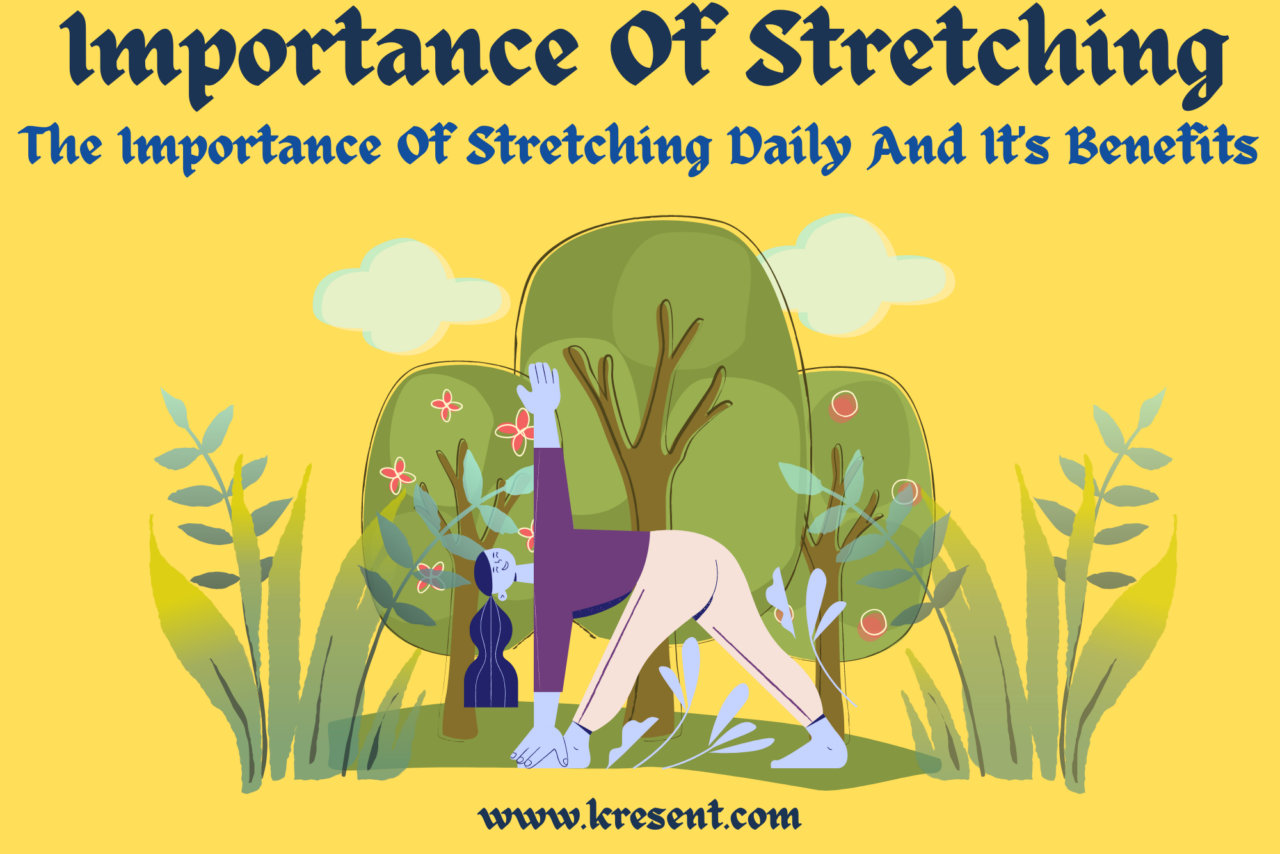
Benefits Of Stretching Daily:
If, is stretching good is a question, here are the benefits of stretching daily.
- The range of motion around the joints increases.
- Risk of injury and falling decreases.
- The feeling of pain reduces.
- Body balance increases.
- Eases and improves posture.
- Improves performance.
- Enhances recovery.
- Facilitates good aging of the body.
What Is Stretching Exercise?
Stretching occurs naturally too as we stretch after we wake up, but that’s not enough for the amount of rigidness built up. So, a more therapeutic way of stretching is needed, in the form of physical exercise.
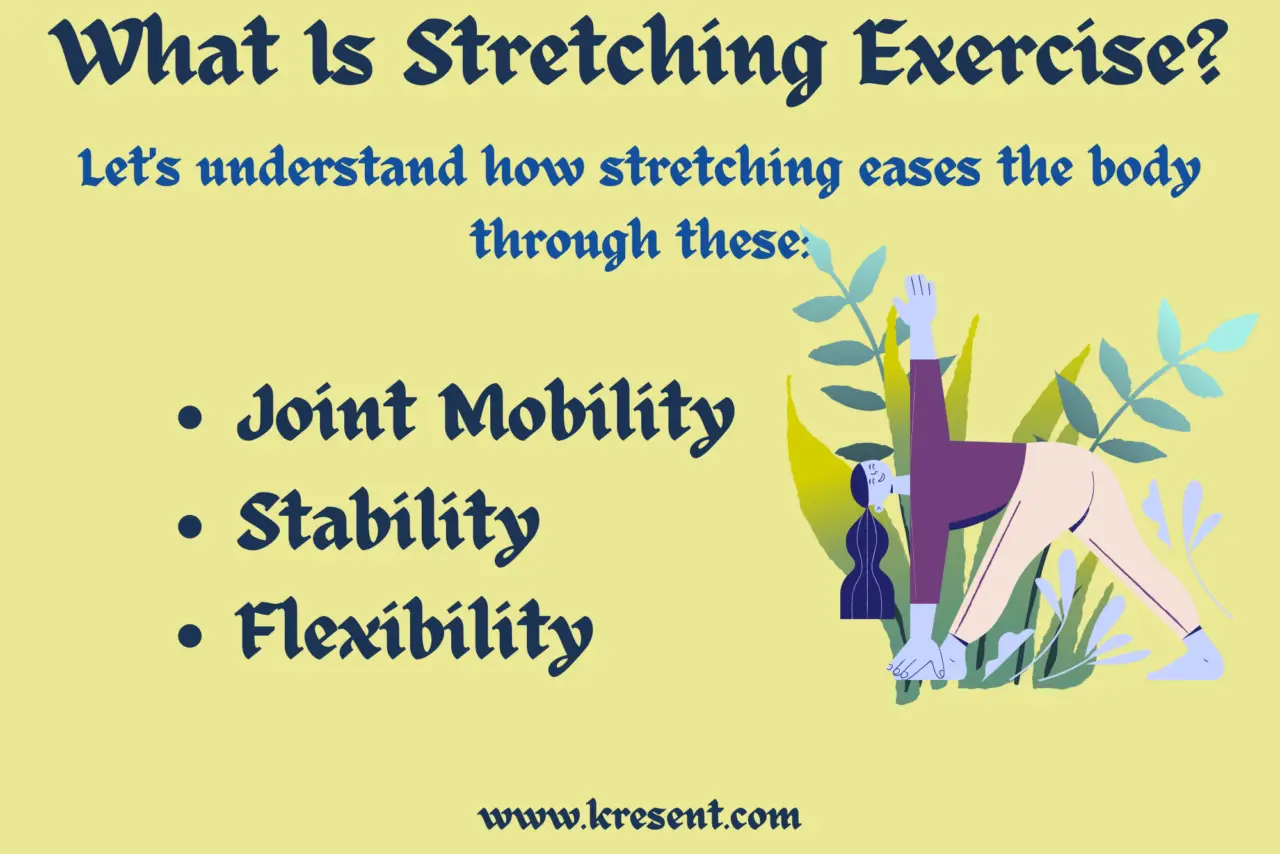
Stretching is one in which a specific muscle or tendon is flexed or stretched in order to improve the muscle’s felt elasticity and achieve comfortable muscle tone. This results in the benefits of stretching daily like a feeling of increased muscle control, flexibility, and range of motion.
Let’s understand how stretching eases the body through these:
Joint Mobility:
It is the level to which the joints move freely without being hindered by the surrounding muscles, tendons, or ligaments. This describes the range of motion around the joint.
Check out with your shoulder rotating it into a full circle.
Stability:
This is the ability to control the joint movement, as we cannot just let the joint fall off and a certain angle is required according to our action.
This is the combination of tissues surrounding the joints and the neuromuscular system. This helps maintain our posture with balance and produces fluid movement.
Flexibility:
The ability of the connective muscles and tissues to lengthen or stretch without pain and injury.
There is a connection between mobility and flexibility. For good mobility around the joints, the surrounding muscles have to be flexible enough to stretch and lengthen according to the work we do.
Flexibility reduces naturally with age and it can be achieved through stretching.
Types Of Stretching:
With the importance of stretching known, there are types of stretching to choose for the requirement of one’s own body and body type.
Dynamic Stretching Exercises:
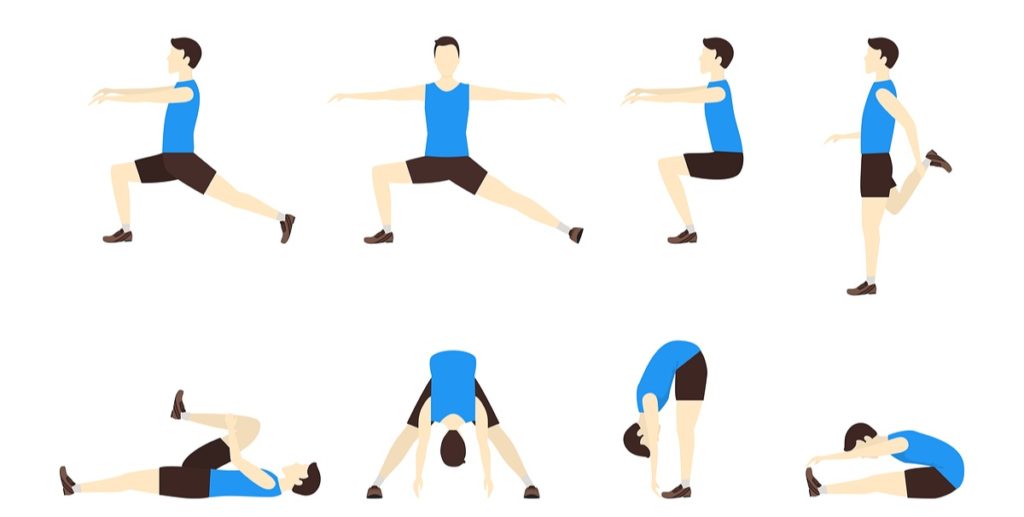
This involves repeatedly moving the joint through the range of motion. In this, you don’t hold a position but move progressively around the joint.
Dynamic stretching exercises are good warm-up muscles before workouts such as:
- Shoulder Rotations
- Neck rolls
- Making circles with arms outstretched
- Ankle Rotations
- Repeated leg lifts or swings
- Butt-kicks
- Dynamic cat-camel stretch
- Bicep curls
- Tricep kickbacks
- Shoulder Raises
This can be done for 10 minutes depending upon the activity.
Static Stretching Exercises:
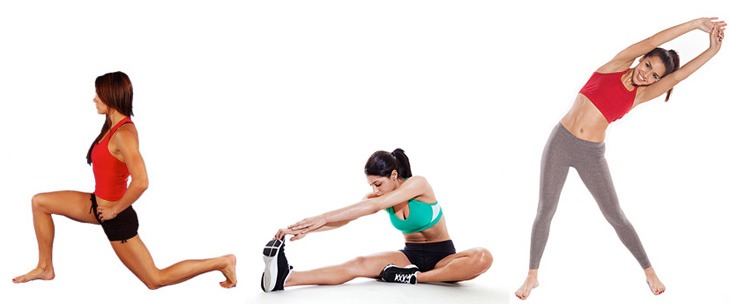
The Static stretching exercises are done by holding the pose for about 30 seconds and changing the side or releasing the pose. No dynamic movement, unlike dynamic stretching.
These are done after the workout or activity to release the contraction of the muscles due to workout. It is important to not to overdo.
Full-Body Stretching Exercises:
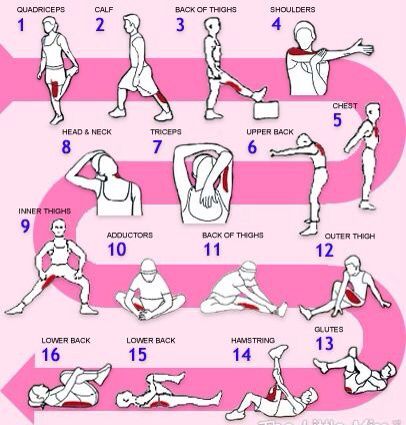
You can do the full body stretch separately as shown in the image above or go for a yoga pose called Adho Mukha Svanasana.
Yoga For Stretching:
Stiff neck, sore muscles, drooping shoulders, and shallow breathing can add to the burden of a long day, but all this is mostly our own fault. We choose sedentary lifestyles, where the physical space we occupy and move in is increasingly restricted to a box-like structure around our chest and abdomen. This means that joints which are capable of a high range of motion, like the shoulder, slowly go out of commission.
Where there is restricted movement, there is restricted blood flow and sluggish lymph drainage (removal of cellular waste). Stagnation of movement leads to pain which is when most of us will sit up and pay attention.
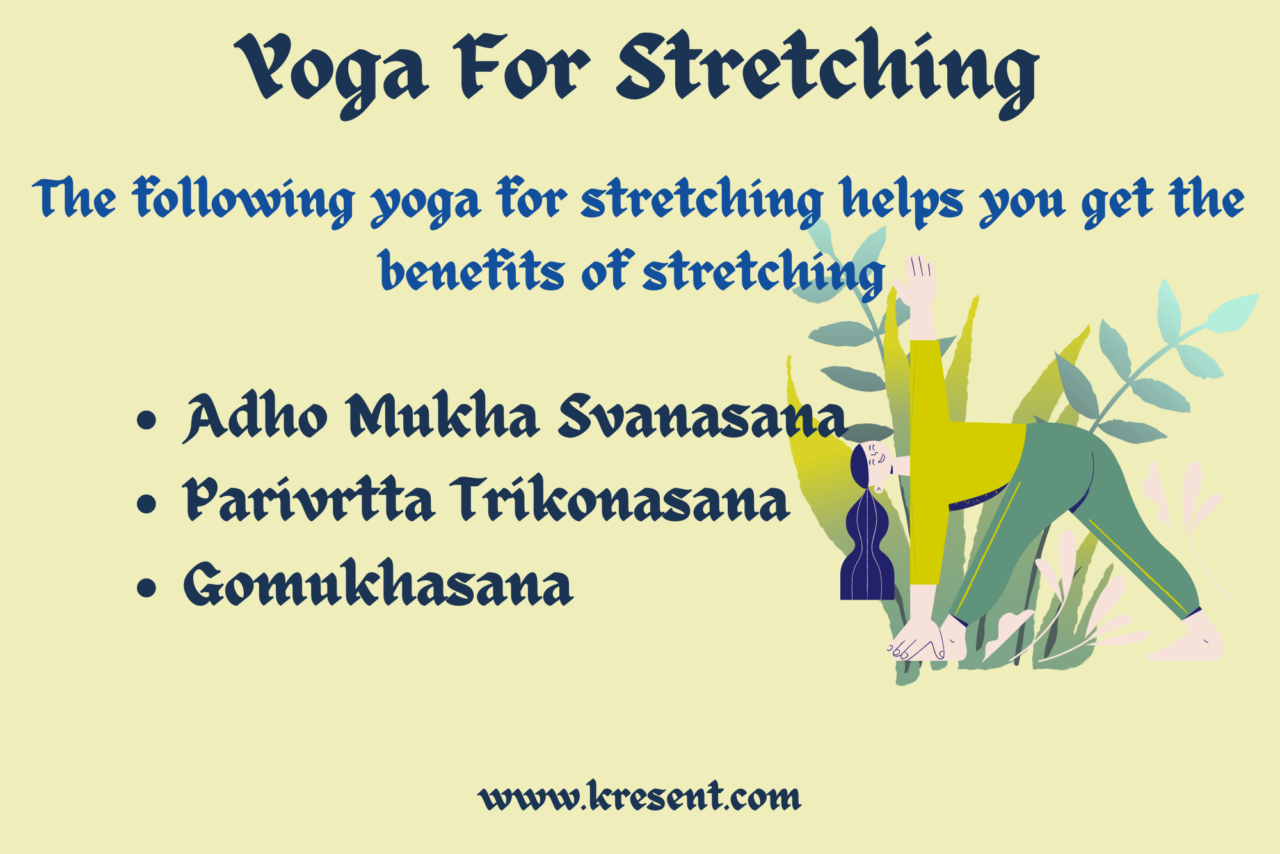
The following yoga for stretching helps you get the benefits of stretching and the experience importance of stretching.
1. Adho Mukha Svanasana (Downward Facing Dog Pose):
This pose calms the mind, lengthens the spine, and energizes the body.
Adho Mukha Svanasana Steps:
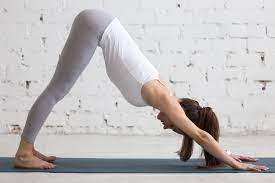
- Stand on your four limbs like a table with palms placed shoulder-width apart and toes placed hip-width apart parallelly.
- Exhale; lift the knees off the floor, legs straight, and form an inverted V-shape pushing the body weight into the palms and hips up towards the ceiling.
- Keep neck neutral and body weight evenly distributed. Touch the ears to the inner arms and sink your hands into the ground.
- Stay in this position and take deep breaths.
Release the pose by getting back to the table pose and bending your knees while exhaling.
2. Parivrtta Trikonasana (Revolved Triangle Pose):
The Parivrtta Trikonasana or revolved triangle pose is good for a really good stretch. Hold it for about five breaths if you’re doing it before a workout and for about eight after. You can do it anywhere from one to three 1-3 times on each side.
This pose stretches the legs, hips, and spine, thereby strengthening them. It opens the chest and improves breathing, improves balance and relieves lower back pain, and also stimulates the abdominal organs.

Parivrtta Trikonasana Steps:
- Inhale; separate the feet, 4 feet apart. Place hands on the waist. Open the right foot 90 degrees and turn the left foot 45 to 60 degrees in towards the right. Align the right and left ankle. Firm the thighs and make sure that the right kneecap is in line with the center of the right ankle (the knee should not be bent forwards.
- Exhale; turn your torso and hips to the right. Firm the left thigh and ground the left heel.
- Inhale; raise the left arm up stretching and lengthening the left side of the waist.
- Exhale; extend the torso forward over the right leg. Extend your left hand down, either to the floor (inside or outside of the foot). If you are not able to, place a block near your foot (inside or outside) and put your palm on the block. Now begin to rotate your torso to the right opening up the chest and rolling the shoulders back, raising the right arm up towards the ceiling.
- If you are a beginner, keep the neck in a neutral position, facing the floor or the wall. If you are an intermediate student then turn the neck to look towards the right thumb.
- Hold the pose for 5-8 breaths, breathing normally. Then repeat on the other side.
Release the pose with inhalation, lifting the head up and release the palms and exhale lift the torso up slowly and place the palms on the waist.
3. Gomukhasana (Cow Face Pose):
This pose strengthens the legs and releases tension around the hip flexors and around the shoulders.
It strengthens the shoulders and extends the upper spine, releasing tension around the shoulders.

Gomukhasana Steps:
- Sit cross-legged on the ground or at the edge of a chair and rotate your wrists clockwise and counter clock-wise.
- Roll the shoulders up towards the ears and drop them down towards the hips. Focus on the breath.
- Inhale; lift the right arm up, above the head. Exhale; bend the right arm from the elbow and take it behind the upper spine, palm facing the spine.
- Inhale; bend the left arm at the elbow and take it behind the middle back, palm facing away from the spine.
- Try and lock the right palm facing towards the spine and the left hand facing away from the spine, with the fingers together and bent like a hook.
- Hold the pose breathing deeply, extending the spine, and opening the chest with every inhalation.
- Maintain the opening with every exhalation. Hold the pose for 5 to 10 breaths; release.
Repeat on the left arm; relax.
Take Away:
Understanding the importance of stretching doesn’t mean overdoing it. Do not overdo it as it may lead to muscle cramps and other side effects of weakening muscles etc. Stretching has to comfort the muscles, so do it as much as it is in your comfort zone.
FAQs
Is stretching important before exercise?
Stretching prior to exercise allows the muscles to loosen up and become resistant to the impact they are about to undergo, thereby reducing the chance of injury.
What happens if you don’t stretch?
Your Body Will Become More Vulnerable to Muscle Pain and Tightness. Without regular stretching, your body gets cold, and your muscles tighten up. Eventually, your muscles will pull on your joints and trigger significant pain and discomfort.
What happens when you stretch every day?
Regular stretching helps increase your range of motion in the joints, improves blood circulation and posture, and alleviates muscular tension throughout the body.
What are the benefits of stretching in the morning?
Stretching first thing in the morning can relieve any tension or pain from sleeping the night before. It also helps increase your blood flow and prepares your body for the day ahead.
What are the disadvantages of stretching?
It can cause micro-trauma or tears in the muscles or connective tissue. As a result, this can create a weakness that may surface later in the run. Stretching should be performed for a prescribed period of time, generally not to exceed 5 to 10 minutes.
What happens when you stretch after sleeping?
When you sleep, muscles relax, blood flow decreases, and your heart rate slows. If you are lying in the same position all night, your muscles tend to tighten up. Humans, like other animals, instinctively stretch after sleeping to get the blood flowing and wake up the muscles.
How long should you hold a stretch?
For optimal results, you should spend a total of 60 seconds on each stretching exercise. So, if you can hold a particular stretch for 15 seconds, repeating it three more times would be ideal. If you can hold the stretch for 20 seconds, two more repetitions would do the trick.